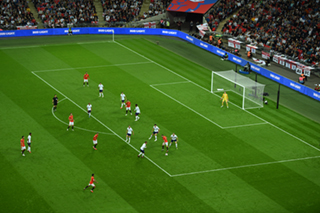
30 questions to help you understand the low-block
- Phil Church
- 24 June 2020
Use these 30 questions to help you develop your understanding of the low-block defensive strategy.
Please note: the content of this article is reflective of resources used at FA UEFA A (FA Level four). Please consider appropriate delivery with your players.
Observational frameworks can help coaches develop a better understanding of the elite game.
Develop your understanding of defending in a low-block by watching the video below and considering the questions provided.
Questions to consider:
Team shape and strategy
What are Wolves allowing Manchester United to do and what are they not prepared to let happen?
Consider:
- When are they engaging?
- Are they engaging 5 metres outside the penalty box?
- Are they engaging five metres inside the halfway line?
- What’s the shape of the team before they engage and put pressure on the ball?
- What depth of that is from the goal?
- What is the distance between the backline and the frontline?
- What are the numbers in each unit?
- What are the distances between the units?
- What are the distances between individual players?
Understanding defensive triggers
As Manchester United enter a particular part of the pitch, a Wolves player does something - what is it?
Consider the following:
- What happens first?
- Why do they do it? And what do they do?
- What is the impact on the player next to them and how does that shift?
Individual roles and responsibilities
For the initial player who applies pressure, consider:
Decision-making:
- Why do they go?
- What was the trigger?
- Was it a backwards pass?
- Was it a bad touch?
- Was it because the opposition entered a particular part of the pitch?
- Is there a specific player that they’re paying attention to?
Individual actions:
- What pace do they move at?
- What is their body shape like as they move?
- When do they slow down?
- How do they pivot?
- What are their turning mechanics like?
- Most importantly: what are they trying to achieve?
Unit and team actions
As that happens, what does the next player do and what is their role? From here, what does the next player do?
Continue to work through the team in the same way.
Applying technical detail in your coaching sessions
Once you have studied the footage and answered the questions think about the implications on practice design.
Crucially, think about how you would deliver this content for the age and stage of the players you work with.
What is appropriate now and what can wait for later?
If you enjoyed this article, take a look at these:
Please note the content above is reflective of the technical and tactical discussions delivered on the UEFA A Licence (FA Level four) course.
To learn new skills and to enhance your technical and tactical knowledge, visit our webinar playlist on YouTube.


